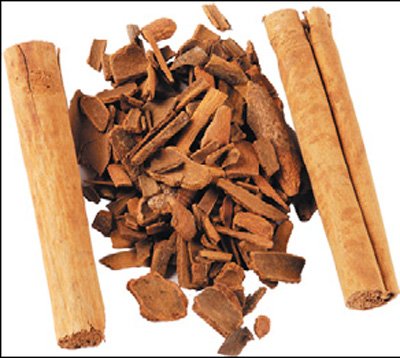Cinnamon
Ayurvedic Medicine

Cinnamon
Cinnamon (E), Ceylon cinnamon (E), Cassia (E), Dalchini (H):
Twak means 'skin' or 'bark'; the bark of the cinnamon tree is used in ayurvedic medicine as a major digestive herb. As a bark protects a tree, cinnamon protects and strengthens the intestines.
Lungs Colds, cough, sinus congestion, bronchitis with excess avalambaka kapha; it clears mucus and encourages the circulation of vata throughout the respiratory system. Use it as a hot decoction to clear ama in fevers by encouraging sweating . Digestion Cold digestion, slow digestion and mandagni in kapha and vata types. Increases agni and regulates samana vayu to treat flatulence and colic. Can be useful in diarrhoea with loose and watery motions with undigested food in the stool. Cinnamon has an antifungal activity and may be used in Candida albicans and imbalanced intestinal flora (WHO 1999). Circulation Cold extremities, Raynaud's syndrome, arthritis; cinnamon stimulates vyana vayu and pushes circulation to the joints. Its warm, dry and light qualities help to clear excess s´lesmaka kapha and ama from the joints. These effects can also be of use in cardiac insufficiency with cold extremities, difficulty breathing, fluid accumulation and tiredness. Urine Frequent urination; nocturia caused by cold is treated by cinnamon's hot and dry qualities. Its ability to penetrate deep into the tissues coupled with its sweet quality give it an ability to nourish the reproductive system (s´ukra dhatu) and treat infertility and male impotence. Gynaecology Dysmenorrhoea; excellent antispasmodic used 3–4 days prior to period in kapha–vata types. It has an ironic action used to treat both amenorrhoea and menorrhagia; its blood-invigorating, warming and penetrating properties can be utilised in wet and stagnant conditions in the pelvic cavity; ovarian cysts, fibroids and endometriosis. Its drying astringency comes to the fore if there is uterine bleeding (Bone 1996, Paranjpe 2001).
 Guduchi
Guduchi Chiretta
Chiretta Garlic
Garlic Devadaru
Devadaru Saffron
Saffron Cumin
Cumin Manjishtha
Manjishtha Mustaka
Mustaka Turmeric
Turmeric Safed Musali
Safed Musali Kapikacchu
Kapikacchu Frankincense (Indian)
Frankincense (Indian) Test your English Language
Test your English Language  What to Eat in Manipur
What to Eat in Manipur What to Eat in Orissa
What to Eat in Orissa Makeover Tips for Cheeks
Makeover Tips for Cheeks Wacky Ideas to attract your Partner
Wacky Ideas to attract your Partner The Worlds Most Magnificent Mosques
The Worlds Most Magnificent Mosques Management Tips
Management Tips Tips to get ready for Winter
Tips to get ready for Winter




